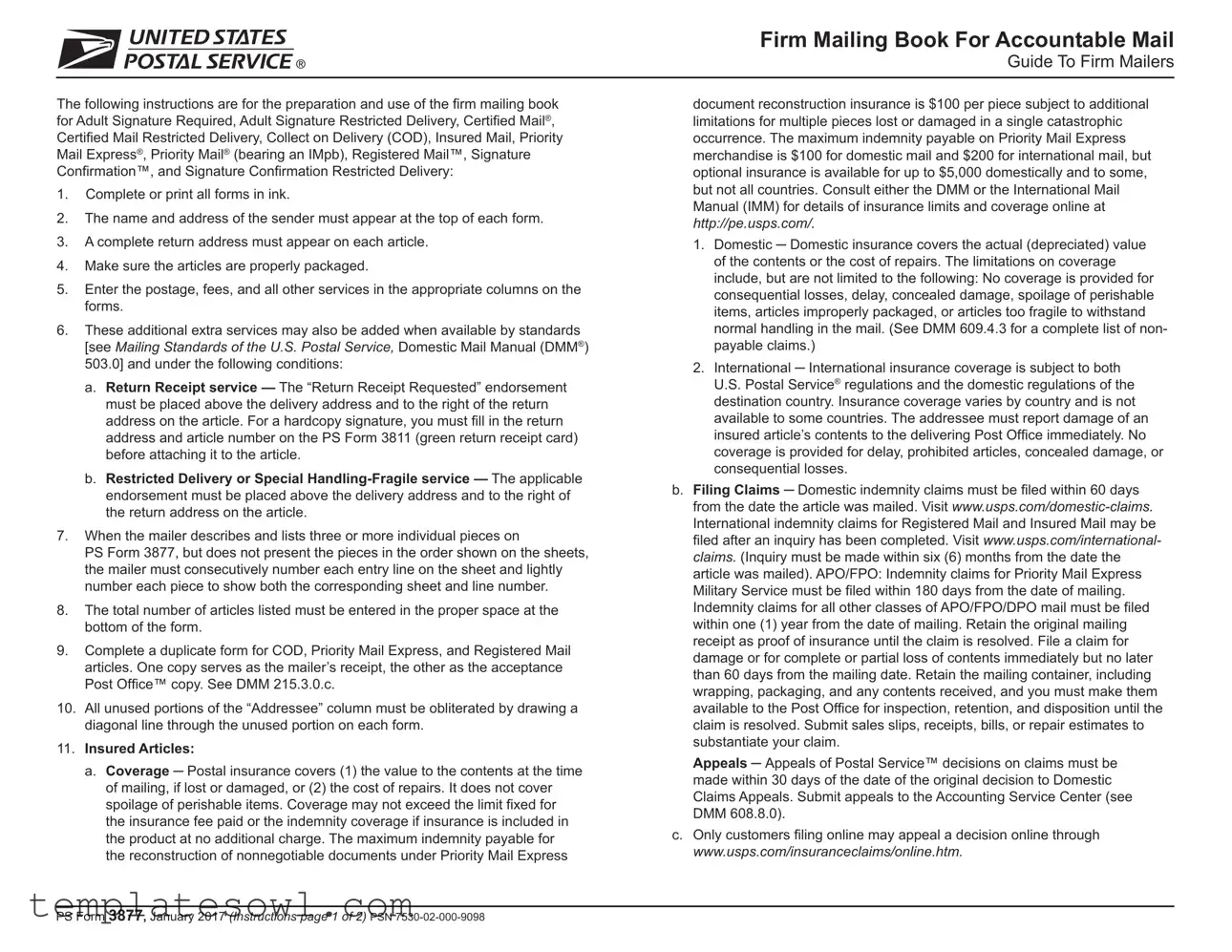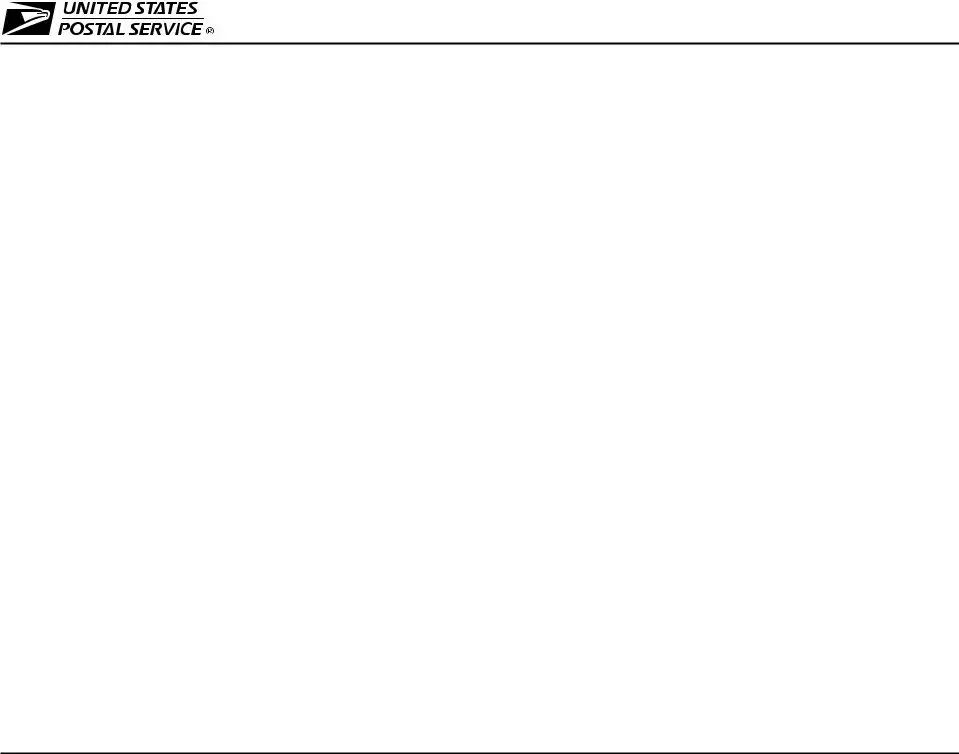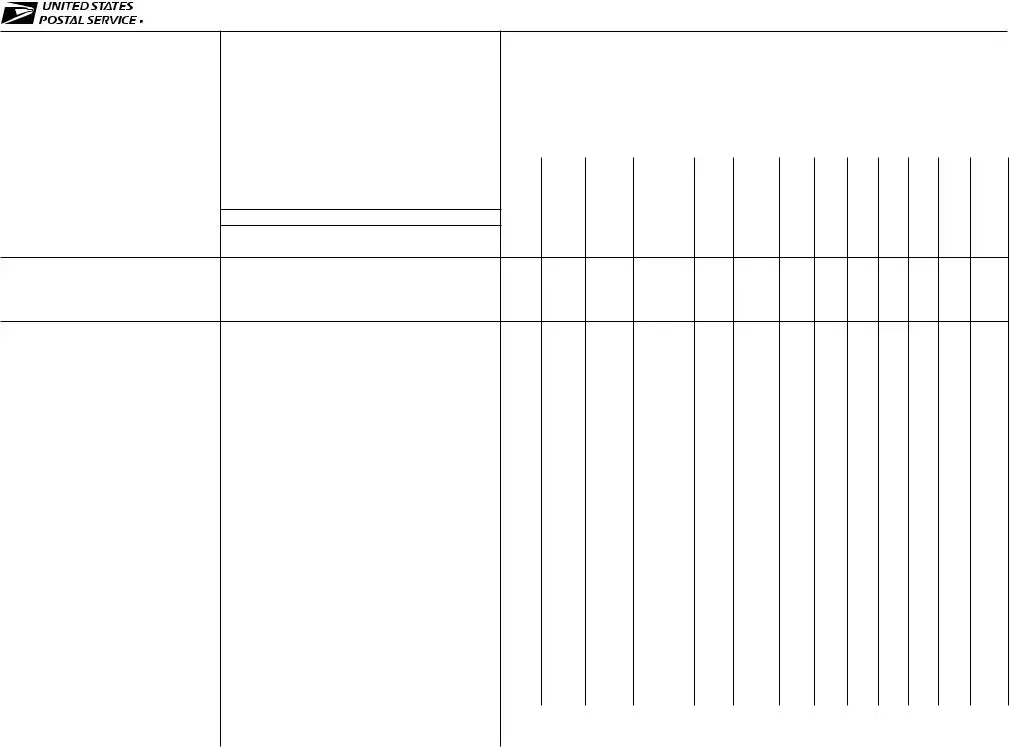The following instructions are for the preparation and use of the irm mailing book for Adult Signature Required, Adult Signature Restricted Delivery, Certiied Mail®,
Certiied Mail Restricted Delivery, Collect on Delivery (COD), Insured Mail, Priority Mail Express®, Priority Mail® (bearing an IMpb), Registered Mail™, Signature
Conirmation™, and Signature Conirmation Restricted Delivery:
1.Complete or print all forms in ink.
2.The name and address of the sender must appear at the top of each form.
3.A complete return address must appear on each article.
4.Make sure the articles are properly packaged.
5.Enter the postage, fees, and all other services in the appropriate columns on the forms.
6.These additional extra services may also be added when available by standards
[see Mailing Standards of the U.S. Postal Service, Domestic Mail Manual (DMM®)
503.0] and under the following conditions:
a.Return Receipt service — The “Return Receipt Requested” endorsement must be placed above the delivery address and to the right of the return address on the article. For a hardcopy signature, you must ill in the return address and article number on the PS Form 3811 (green return receipt card) before attaching it to the article.
b.Restricted Delivery or Special Handling-Fragile service — The applicable endorsement must be placed above the delivery address and to the right of the return address on the article.
7.When the mailer describes and lists three or more individual pieces on
PS Form 3877, but does not present the pieces in the order shown on the sheets, the mailer must consecutively number each entry line on the sheet and lightly number each piece to show both the corresponding sheet and line number.
8.The total number of articles listed must be entered in the proper space at the bottom of the form.
9.Complete a duplicate form for COD, Priority Mail Express, and Registered Mail articles. One copy serves as the mailer’s receipt, the other as the acceptance Post Ofice™ copy. See DMM 215.3.0.c.
10.All unused portions of the “Addressee” column must be obliterated by drawing a diagonal line through the unused portion on each form.
11.Insured Articles:
a.Coverage ─ Postal insurance covers (1) the value to the contents at the time of mailing, if lost or damaged, or (2) the cost of repairs. It does not cover spoilage of perishable items. Coverage may not exceed the limit ixed for the insurance fee paid or the indemnity coverage if insurance is included in the product at no additional charge. The maximum indemnity payable for the reconstruction of nonnegotiable documents under Priority Mail Express
document reconstruction insurance is $100 per piece subject to additional limitations for multiple pieces lost or damaged in a single catastrophic occurrence. The maximum indemnity payable on Priority Mail Express merchandise is $100 for domestic mail and $200 for international mail, but optional insurance is available for up to $5,000 domestically and to some, but not all countries. Consult either the DMM or the International Mail Manual (IMM) for details of insurance limits and coverage online at
http://pe.usps.com/.
1.Domestic ─ Domestic insurance covers the actual (depreciated) value of the contents or the cost of repairs. The limitations on coverage include, but are not limited to the following: No coverage is provided for consequential losses, delay, concealed damage, spoilage of perishable items, articles improperly packaged, or articles too fragile to withstand normal handling in the mail. (See DMM 609.4.3 for a complete list of non- payable claims.)
2.International ─ International insurance coverage is subject to both U.S. Postal Service® regulations and the domestic regulations of the destination country. Insurance coverage varies by country and is not available to some countries. The addressee must report damage of an insured article’s contents to the delivering Post Ofice immediately. No coverage is provided for delay, prohibited articles, concealed damage, or consequential losses.
b.Filing Claims ─ Domestic indemnity claims must be iled within 60 days from the date the article was mailed. Visit www.usps.com/domestic-claims.
International indemnity claims for Registered Mail and Insured Mail may be iled after an inquiry has been completed. Visit www.usps.com/international- claims. (Inquiry must be made within six (6) months from the date the article was mailed). APO/FPO: Indemnity claims for Priority Mail Express Military Service must be iled within 180 days from the date of mailing. Indemnity claims for all other classes of APO/FPO/DPO mail must be iled within one (1) year from the date of mailing. Retain the original mailing receipt as proof of insurance until the claim is resolved. File a claim for damage or for complete or partial loss of contents immediately but no later than 60 days from the mailing date. Retain the mailing container, including wrapping, packaging, and any contents received, and you must make them available to the Post Ofice for inspection, retention, and disposition until the claim is resolved. Submit sales slips, receipts, bills, or repair estimates to substantiate your claim.
Appeals ─ Appeals of Postal Service™ decisions on claims must be made within 30 days of the date of the original decision to Domestic Claims Appeals. Submit appeals to the Accounting Service Center (see DMM 608.8.0).
c.Only customers iling online may appeal a decision online through www.usps.com/insuranceclaims/online.htm.




